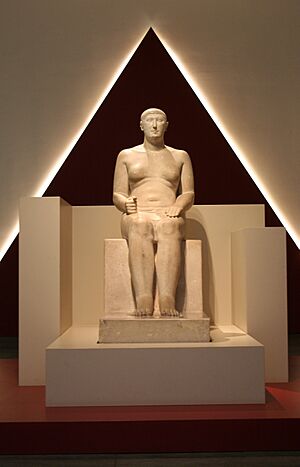Vizier (Ancient Egypt) facts for kids

The vizier was the most powerful official in ancient Egypt, working directly for the pharaoh (king). This important job existed during the Old, Middle, and New Kingdoms. The word "vizier" is how experts on ancient Egypt, called Egyptologists, usually say the ancient Egyptian word tjati or tjaty. A special ancient text from the New Kingdom, called the Installation of the Vizier, explains many of the vizier's duties and how they should act. Pharaohs often chose their viziers. In the early dynasties (the 4th and 5th Dynasties), only members of the royal family could be viziers. Later, people were chosen based on their loyalty and skills, or they inherited the job from their fathers.
What Did a Vizier Do?
Pharaohs chose the viziers for their important roles. The vizier's main job was to manage the entire country, much like a prime minister does today. Sometimes, this even included small tasks like checking the city's water supply! All other officials, like tax collectors and scribes (people who wrote things down), reported to the vizier.
The vizier was also in charge of the justice system and was a judge in the highest court. However, the pharaoh always had the final say and could change any of the vizier's decisions. Viziers also made sure the pharaoh and the palace were safe by watching who came and went. They often acted as the pharaoh's official seal bearer and kept records of trade.
From the Fifth Dynasty onwards, viziers became the top government officials. They were responsible for running the palace and the government. This included managing laws, supervising scribes, keeping state records, overseeing food storage, handling the treasury, and distributing extra goods. They also supervised big building projects, like the royal pyramids. In the New Kingdom, there were even two viziers: one for Upper Egypt and one for Lower Egypt.
How to Be a Good Vizier
The Installation of the Vizier is an old document from the New Kingdom. It describes the important qualities and behaviors a vizier needed to have. Here are some of them:
- Always follow the law.
- Make fair judgments for everyone.
- Do not act stubbornly or without thinking.
See also

